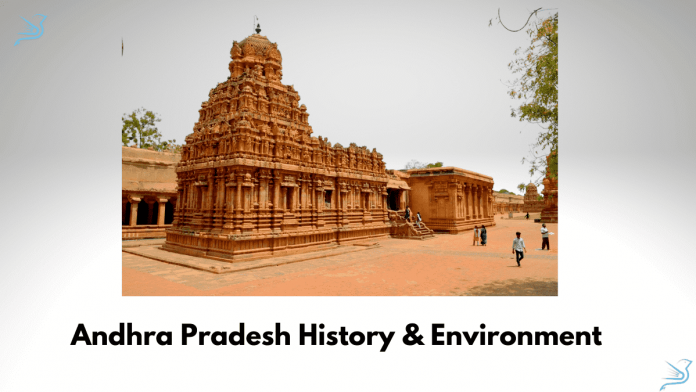Hope you all must have read our last blog that focused on the cultural, geographical and political aspects of Andhra Pradesh. If you haven’t checked it out already click here Andhra Pradesh art & culture. Andhra Pradesh is a well-known state for its beautiful culture and heritage where one can experience the natural beauty of landscapes, architecture, art and culture.
Do you know the two important rivers i.e. Godavari and Krishna flow majorly through which state? Which is the brightest period of Telugu history?
Now going into deep about Andhra Pradesh, we’ll explore its history, environment and economy. Let’s start with the very first aspect –
Table of Contents
Andhra Pradesh HISTORY
Andhra Pradesh is famous for its glorious past and you will explore the amazing ancient temples, places, monuments, forts and rich culture at this destination.
ANCIENT HISTORY
- In the Ancient Period, Satvahanas and Eastern Chalukyas ruled the state.
- Satvahanas– According to Matsya Purana there were 29 rulers of this dynasty. They ruled over the Andhradesa including Deccan for about 400 years from the 2nd century B.C. to beyond the 2nd century A.D. Salivahanas and Satkarnis are other names of Satvahanas. Simuka was the founder of the Satvahana Dynasty.
- Some of the famous rulers are Satkarni II and Gautamiputra Satkarni.
- There was an excellent literary work written by Gathasaptasati of Hala in the reign of the 17th Satvahana King.
- Eastern Chalukyas– They also ruled in the area of Andhra Pradesh. This dynasty was a branch of the Chalukyas of Badami. They were originally of Kannada stock but they patronized Telugu and gave a fillip to it.
MEDIEVAL HISTORY
- The kingdoms which ruled in the medieval time are: Kakatiyas, Bahmanis, Vijaynagar, Qutb Shahis, and Mughal Rule.
- Kakatiyas- The 12th and the 13th centuries saw the emergence of the Kakatiyas. This period has been rightly called the Brightest Period of Telugu History. The Kakatiya Temple, dedicated mostly to Shiva. The most important of these temples are those at Palampeta and Hanamkota. The temple at Palampeta has been described as the brightest gem in the galaxy of Medieval Deccan temple architecture.
- Bahmanis- The Bahmani Kingdom was established in South India by Alla-ud-din Hasan Gangu by revolting against the Delhi Sultanate.
- Vijaynagar- The year A.D. 1336 saw the emergence of a new power, the kingdom of Vijaynagar in the south-western part of Andhra on the banks of the Tungabhadra. It was founded by Harihara and Bukka, who were two Sangam brothers, with the blessings of a great saint patriot of medieval India, Vidyaranya. Harihara became its first ruler. Sri Krishnadevraya also belonged to the Vijaynagar Kingdom.
- Mughal Rule- Aurangzeb, the Mughal Rule emperor invaded Golconda in 1687 A.D. and annexed it to the Mughal Empire. When this was done, Golconda became part of the Deccan Subha and a Nizam was appointed as an agent of the Mughal Emperor.
MODERN PERIOD
- In the early nineteenth century, Northern Circars was ceded to the British East India Company and became part of the Madras Presidency. Eventually, this region emerged as the Coastal Andhra region.
- Later the Nizam rulers of Hyderabad ceded 5 territories to the British that eventually became the Rayalaseema region.
- The Nizams retained control of interior provinces as the princely state of Hyderabad, acknowledging British rule in return for local autonomy.
- However, Komaram Bheem, a tribal leader started his fight against the erstwhile Asaf Jahi Dynasty for the liberation of Hyderabad state.
- Meanwhile, the French occupied Yanam, in the Godavari delta and would hold it until 1954. In 1974 Vizianagaram was the largest Hindu princely state in Andhra Pradesh.
FREEDOM STRUGGLE IN ANDHRA PRADESH
- In 1920, when Gandhiji started his non-cooperation movement, it had an immediate response in Andhra. Under the leadership of eminent men like Konda Venkatappaiah, Tanguturi Prakasam Panthlu, Bulusu Sambamurti and Bhogaraju Pattabhi Seetaramaiah.
- The “Forest Satyagraha” of the ryots of Palnad in Guntur district in 1921. The peasants of this place had to pay heavy tax for permission to graze their cattle in forest. When the crops failed that year, they decided to send their cattle into the forests without paying the fee and suffer the penalties. British took the cattle forcibly, confined them in cattle-pounds and refused to free them unless the fee was paid.
Andhra Pradesh welcomes you with amazing natural beauty and you will find dense forests, cloudy hills, glittering rivers, undulating mountains and silvery waterfalls in this state. Coming to the next aspect –
Andhra Pradesh ENVIRONMENT
Andhra Pradesh is also famous for many hill stations, national parks, beaches and sanctuaries. The beautiful culture and heritage and eye-catching beauty attract lots of tourists from all over the world to Andhra Pradesh.
Major Dams
- Nagarjunasagar Dam: This dam is built across the Krishna River forming a boundary between the Telangana and Guntur district of Andhra Pradesh.
- Srisailam Dam: It is constructed on the Krishna River at the border of Telangana and Kurnool districts of Andhra Pradesh.
- Polavaram Dam: It is built across the Godavari River which is a multi-purpose irrigation project under construction in Andhra Pradesh.
- Prakasam Barrage: It is built across the Krishna River, located at the outskirts of Vijaywada and the barrage also serves as a road bridge over a lake.
Flora and Fauna
- The vegetation found in the state is large of dry deciduous types with a mixture of Teak, Terminalia, Dalbergia, Pterocarpus, Anogeissus, etc.
- The estuaries of river Godavari and Krishna support rich mangrove forests with fishing cats and others as keystone species.
Important National Parks
There are 3 national parks in the state.
- Sri Venkateswara National Park – It is located on the Eastern Ghats and is home to
- endemic plant species and interesting fauna species like Slender Loris, Wild Dog, etc.
- Papikondalu National Park – Located in the districts of East and West Godavari. The area was declared as a national park recently in 2008.
- Rajiv Gandhi National Park – Located in Rameswaram of Kadapa district, the park lies on the Penna River. An area of Tropical dry deciduous forest mostly growing on sandy soil.
Important Wildlife Sanctuaries
- Nagarjunasagar Wildlife Sanctuary – This is located in Srisailam and is often referred to as Nagarjunasaga-Srisailam Sanctuary. The sanctuary has 150 species of birds which include Grey Hornbill and pea fouls.
- Coringa Wildlife Sanctuary – Located in Kakinada, it is famous for being home to critically endangered white-backed vulture and long-billed vulture.
- Kaundiya Wildlife Sanctuary – Only sanctuary in the state to have a sizeable population of Asian elephants which have migrated from the neighbouring states.
Major Rivers
There are two major rivers that flow through these states and that are: GODAVARI and KRISHNA.
- Godavari – This River rises from Trimbakeshwar in the Nashik district of Maharashtra and empties into the Bay of Bengal. The Satmala Hills are in the North of the Godavari basin, the Ajanta range and the Mahadeo hills are in the South, the Eastern Ghats are on the East, and the Western Ghats are on it’s West. It is also known as “Dakshin Ganga”. It extends over the states of Maharashtra, Andhra Pradesh, Chattisgarh and Odisha in addition to smaller parts in Madhya Pradesh, Karnataka and Union Territory of Puducherry. The principal tributaries of the river are:
RIGHT – The Pravara, the Maxer and the Manjra
LEFT – The Penganga, the Wardha, the Wainganga and the Pranhita, the Indravati, the Purna and the Sabri.
- Krishna – The Krishna River originates in the Western Ghats near Mahabaleshwar. The Krishna River is the biggest river in terms of water inflows and river basins area in India, after the Ganga, the Godavari and the Brahmaputra. It spreads over Andhra Pradesh, Maharashtra and Karnataka. The river merges into the Bay of Bengal of Hamasaladeevi. The major tributaries are –
LEFT – Bhima, Dindi, Peddavagu, Halia, Musi, Paleru and Munneru
RIGHT – Veena, Koyna, Panchganga, Dudhganga, Ghataprabha, Malaprabha and Tungabhadra.
Andhra Pradesh ECONOMY
For any state, the economy plays a significant role in its growth as well as development. The following points show the economical aspect of Andhra Pradesh.
- The state ranks 9th in terms of GDP, with Rs.11.0 lakh crore.
- The GDP growth rate of Andhra Pradesh for 2018-19 is 15.3%.
- The GDP per capita rank is 16th with Rs. 192,144.
- GDP by sector is –
Agricultural Sector – 34%
Industrial Sector – 23%
Service Sector – 43%
- The Unemployment rate is 4.5% as per 2017-18.
- The state has been ranked the best state in ease of doing business in the country by the World Bank.
- Andhra Pradesh is also known as “Ratna Garbha” of India. Its resources estimate to 110 M tonnes of industrial grade minerals and 200 M tonnes of building material.
- The famous diamonds Kohinoor and Pitt came from the mines of Golconda.
- Tummalpalle mines are a rich source of Uranium.
Andhra Pradesh EDUCATION
According to the census of 2011, the literacy rate of Andhra Pradesh is 67.41%.
- There are total 18 state universities in the districts which provide higher education in horticulture, la, medical, technology, Vedic and veterinary.
- Rajiv Gandhi University of Knowledge Technologies (RGUKT) was established by the government of Andhra Pradesh in 2008 to cater to the education needs of the rural youth of Andhra Pradesh.
- The central universities are All India Institute of Medical Sciences, IIM Vishakhapatnam, IIT Tirupathi, IIITDM Kurnool etc.
- Andhra University is the oldest of the universities in the state, established in 1926.
SPORTS
Talking about sports, the Sports Authority of Andhra Pradesh is the governing body which looks after its infrastructural development.
- Cricket is one of the most popular sports in the state.
- In Vishakhapatnam, there is a stadium which is home to Andhra Pradesh cricket team i.e. ACA-VDCA stadium.
- The youngest woman ever to become a grandmaster in chess is Humpy Koneru, from Gudivada of Krishna district.
- The first female Indian to win an Olympic medal is Karnam Malleswar, hails from Srikakulam district of Andhra Pradesh.
And at last, here are Some Interesting Facts about Andhra Pradesh which will blow your mind.
- Mallikarjuna Swamy Temple of Srisailam district (Kurnool district) is one of the 12 Jyotirilings of Shiva.
- Sarvepalli Radhakrishnan, the second president of India and Bharat Ratna Award Winner also hails from Andhra Pradesh.
- Tanguturi Prakasam is also known as “Andhra Kesan”.
- The magnificent Falaknuma palace of Hyderabad was built by Nawab Viqar-Ul-Umra in the year 1893. It was later turned into a luxurious hotel.
- The present capital i.e. Due to the diplomacy of Sardar Vallabhbhai Patel, Hyderabad was captured on 17 September 1948 by a military operation named “Operation Polo”.
So, this was all the required essential information that you’ll be needing while preparing for your competitive exams such as Civil Services, CDS, SSC CGL, etc. Hope this blog would help you in understanding this state.
In our next blog, we will be discussing everything that you need to know about the state of Arunachal Pradesh.
If you wish to read about South Indian states, you can click on the link and read our informative blogs about the states of Kerala, Tamil Nadu, Telangana, and Karnataka.
Thank You




